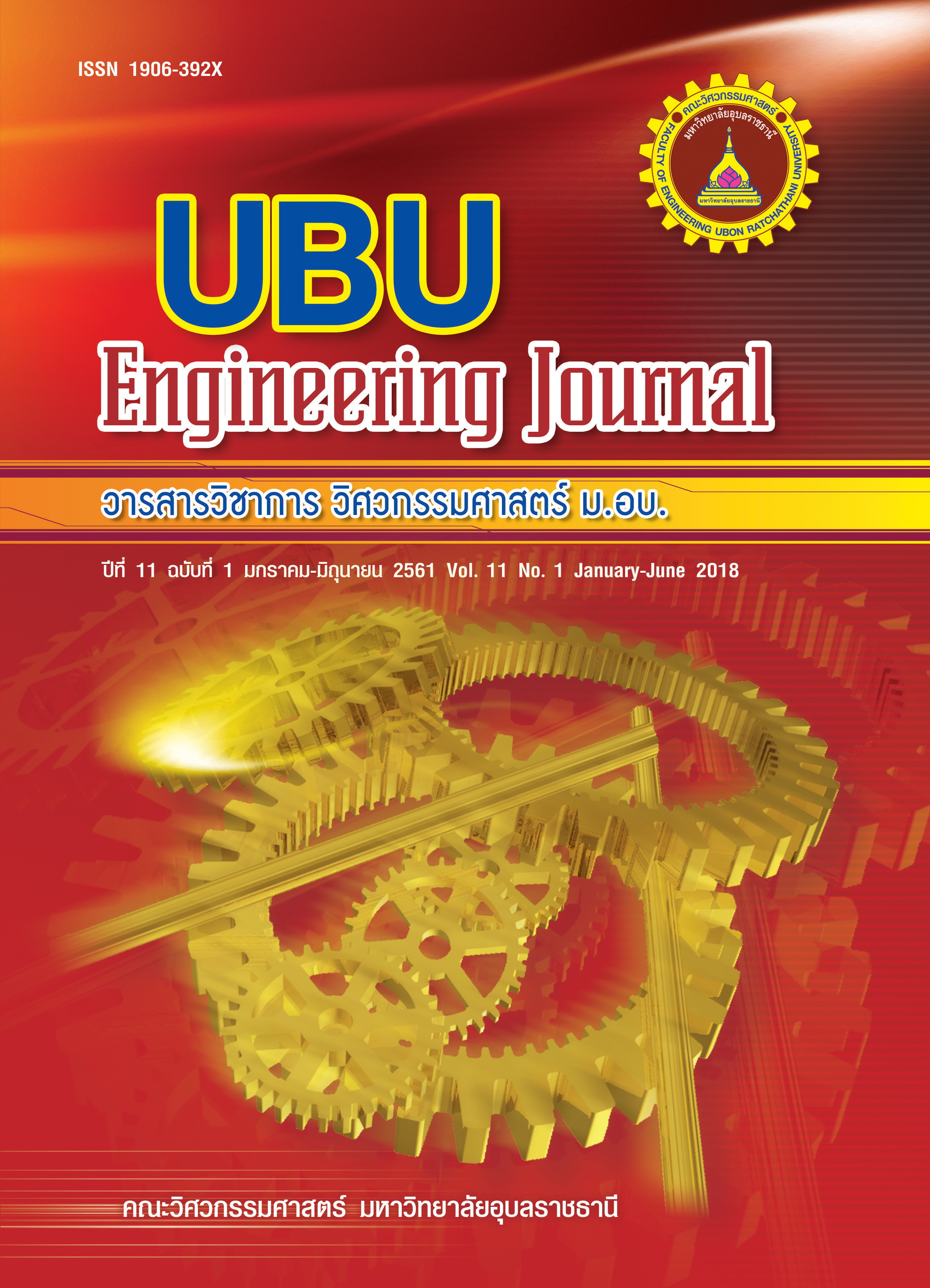การปรับปรุงสมรรถนะของเตาแก๊สหุงต้มเชื้อเพลิงแก๊สชีวภาพ
Main Article Content
บทคัดย่อ
วัตถุประสงค์หลักของงานวิจัยนี้เพื่อนำเสนอผลการศึกษาสมรรถนะของเตาแก๊สหุงต้มเชื้อเพลิงแก๊สชีวภาพ โดยการปรับปรุงหัวฉีดแก๊สเชื้อเพลิง ท่อผสมและหัวเตาเพื่อให้ได้สมรรถนะเพิ่มมากขึ้น ภายใต้การปรับขนาดเส้นผ่านศูนย์กลางของหัวฉีดแก๊สเชื้อเพลิงและคอคอดในช่วงจาก 0.8 ถึง 1.3 มิลลิเมตร และ 17 ถึง 24 มิลลิเมตร ตามลำดับ นอกจากนั้นรูทางออกของเปลวไฟได้ถูกปรับปรุงให้เป็นแบบหมุนวน การทดสอบสมรรถนะการเผาไหม้ของเตาใช้การทดสอบตามมาตรฐาน DIN EN 203-2 โดยศึกษาอิทธิพลของขนาดเส้นผ่านศูนย์กลางของหัวฉีดแก๊สเชื้อเพลิงและคอคอดต่อสมรรถนะการเผาไหม้ เช่น ประสิทธิภาพเชิงความร้อนและมลพิษ ผลจากการศึกษาพบว่าขนาดเส้นผ่านศูนย์กลางที่เหมาะสมของหัวฉีดแก๊สและคอคอดคือ 1.2 และ 20 มิลลิเมตร ตามลำดับ เนื่องจากให้ประสิทธิภาพเชิงความร้อนสูงสุดและยังปลดปล่อยมลพิษ CO น้อยที่สุด ในขณะเดียวกันหัวเผาแบบหมุนวน (SB) ช่วยเพิ่มประสิทธิภาพเชิงความร้อนสูงขึ้นและปลดปล่อยมลพิษ CO ค่อนข้างสูงกว่าหัวเตาดั้งเดิมแบบไหลตามแนวรัศมี (RB) อย่างไรก็ตามมลพิษ CO ยังคงต่ำกว่าค่ามาตรฐานที่กำหนด (1,500 ppm ที่ 0% excess O2)
Article Details
References
[2] วสันต์ โยคเสนะกุล. หัวเผาเชื้อเพลิงแก๊สที่มีการหมุนเวียนความร้อนและการไหลแบบหมุนวน. วิทยานิพนธ์หลักสูตรปริญญาวิศวกรรมศาสตรมหาบัณฑิตสาขาวิชาวิศวกรรมเครื่องกล คณะวิศวกรรมศาสตร์ มหาวิทยาลัยเทคโนโลยีพระจอมเกล้าธนบุรี. 2547.
[3] Weinberg, FJ. Heat-recirculating burners. principles and some recent developments. Combustion Science and Technology. 1986; 121: 3−22.
[4] Yoshizawa Y. Echigo R, Tomimura T. A study on a high performance radiant heater. In: Proceedings of the 2nd ASME/JSME Thermal Engineering Joint Conference; 1987. p. 317−323.
[5] ณัฐวุฒิ รังสิมันตุชาติ. การประยุกต์ใช้วัสดุพรุนเพื่อการประหยัดพลังงานในเตาแก๊สหุงต้ม. วิทยานิพนธ์หลักสูตรปริญญาวิศวกรรมศาสตรมหาบัณฑิตสาขาวิชาวิศวกรรมเครื่องกล คณะวิศวกรรมศาสตร์ มหาวิทยาลัยเทคโนโลยีพระจอมเกล้าธนบุรี. 2544.
[6] Jugjai S, Rungsimuntuchart N. High efficiency heat recirculating domestic gas burners. Experimental Thermal and Fluid Science. 2002; 26: 581–592.
[7] Pantangi VK, et al. Studies on porous radiant burners for LPG (Liquefied Petroleum Gas) cooking applications. Energy. 2011; 36: 1–7.
[8] Muthukumar P, Shyamkumar PI. Development of novel porous radiant burners for LPG cooking applications. Fuel. 2011; 112: 562–566.
[9] Shtern V, Borissov A, Hussain F. Temperature distribution in swirling jets. International Journal of Heat and Mass Transfer. 1998; 41: 2455−2467.
[10] Tamir A, Elperin T, Yotzer S. Performance characteristics of a gas burner with a swirling central flame. Energy. 1989; 14: 373−382.
[11] Tamir A. A swirling-flame combustor for lean mixtures. Combustion Science and Technology. 1993; 90: 193−209.
[12] Hou SS, Ko YC. Influence of oblique angle and heating height on flame structure, temperature field and efficiency of an impinging laminar jet flame. Energy Conversion and Management. 2005; 46: 941−958.
[13] Gupta AK, Lilley DG, Syred N. Swirl flows. Taylor & Francis; 1984.
[14] Tamir A, Elperin I, Yotzer S. Performance characteristics of a gas burner with a swirl central flame. Energy. 1992; 14: 347−362.
[15] Saha C, Ganguly R, Datta A. Heat transfer and emission characteristics of impinging rich methane and ethylene jet flames. Experimental Heat Transfer. 2008; 21: 169−187.
[16] Chander S, Ray A. Flame impingement heat transfer: a review. Energy Conversion and Management. 2005; 46: 2803−2837.
[17] Kurchania AK, Panwar NL, Pagar SD. Development of domestic biogas stove. Biomass Conversion and Biorefinery. 2011; 1: 99−103.
[18] Mahin D.B. Biogas in developing countries, Bioenergy system report to USAID, Washington D.C. 1992.
[19] Chan US. State of the art review on the integrated use of anaerobic processes in China. Internal report prepared for IRCWD. 1982.
[20] Dutt GS, Ravindranath NH. Distribution of tree species on different sized farms in a semi-arid village, Farm forestry in South Asia, Sage Publications, India. 1993.
[21] Burbano HJ, Amell AA, Garcıa JM. Effects of hydrogen addition to methane on the flame structure and CO emissions in atmospheric burners. International Journal of Hydrogen Energy. 2008; 33: 3410−3415.
[22] Jadhav P, Sudhakar DS. Analysis of burner for biogas by computational fluid dynamics and optimization of design by genetic algorithm. International Journal for Research in Emerging Science and Technology. 2015; 2: 39−44.
[23] อภินันต์ นามเขต, สำเริง จักรใจ. คุณลักษณะการเหนี่ยวนำอากาศส่วนแรกของหัวเผาแบบ Self – aspirating. ใน: การประชุมวิชาการเครือข่ายวิศวกรรมเครื่องกลแห่งประเทศไทยครั้งที่ 21, ชลบุรี, ประเทศไทย, 17-19 ตุลาคม; 2550.
[24] German Standards and Technical Rules. Gas-heated Catering Equipment. 1997; 203(2): 17 pages.
[25] อนุชา กล่ำน้อย, บัณฑิต กฤตาคม. การประยุกต์ใช้วิธีการถดถอยแบบเส้นตรงเชิงพหุสำหรับทำนายปริมาณ NOx จากการเผาไหม้เชื้อเพลิงแก๊สของหัวพ่นไฟวัสดุพรุนแบบเม็ดกลมอัดแน่น. วารสารวิชาการ วิศวกรรมศาสตร์ ม.อบ. 2559; 9(1): 31−38.
